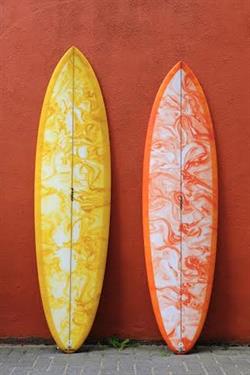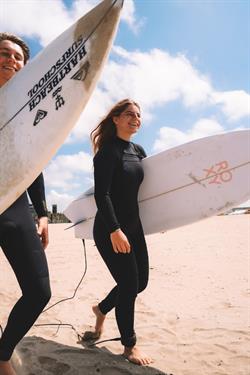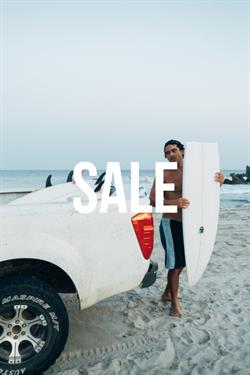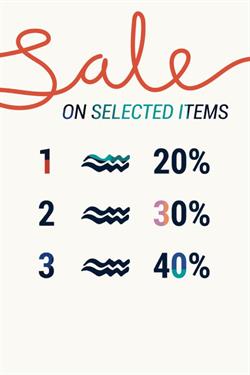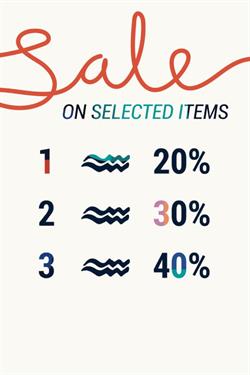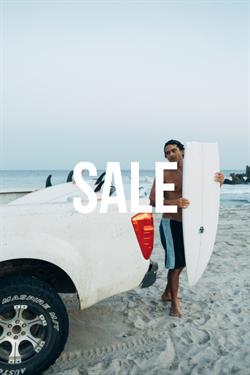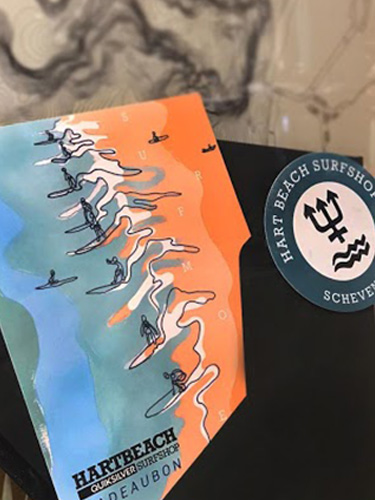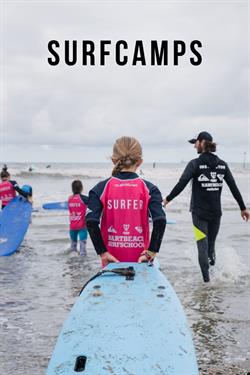One of the most frequent questions we get from both beginners as well as experienced surfers, is a question without a simple answer. Namely: “what fins do I need?”
FINS
One of the most frequent questions we get from both beginner, as well as experienced surfers is one without a simple answer. It’s the question: “what fins do I need?”.
Because your fins make up for almost 50% of the total surface that is in the water when your board is planing, you could say that it’s even as important as any of the questions about your board.
We know you can be overwhelmed by all of the choices, so we want to help you with your decision.
Since finding the right fin is a matter of a lot of variables (weight, type of wave that you are going to surf, the board they are going to be on and much more), so you have to see this as more of a guideline and search aid.
We are going to start off with telling you what a fin actually does for your surfboard.
After that we will be asking you 4 Questions to answer so you can narrow down your search as much as possible and get the best end result.
Let’s begin!
The function of a fin
Fins have two main functions: stability (and pivot point) and lift
1: Stability:
Imagine a board without fins (like for example an Alaia). The board has no surface that sticks in the water that gives you control. Therefore it’s hard to control maneuvers and movement. It’s for example hard to stop from sliding sideways off the wave when going down the line.
Now if you put a (single) fin on the tail of the board, the fin will stop the board from sliding sideways off the wave. It also creates a pivot point from where you can turn.
2: Lift
With a surfboard, the rail of the board is what slices into the wall of the wave, and therefore gives you grip. They help you with speed generation, positioning on the wave and reduce the chance of sliding off the wave sideways. To further reduce the sliding sideways, we put sidefins in a board. These extra surfaces will give you even more control and grip.
Even more important,is that these side fins are foiled like an airplane wing.
Because of two different theories (Bernoulli’s Principle and Newton’s Third Law) this creates “lift”. This makes an airplane fly, but because the foil of a surfboard fin is to the side, this creates pressure towards the wall of the wave.
Important to know is that each fin has function 1, but not all the fins have function 2.
Drag
Also good to know is that a byproduct of the fins in the water is drag. All of the things in the water create resistance or “drag”. So you could say that a finless board goes fastest because there is nothing in the water. The more fins (and the bigger), the more drag.
Let’s go to the questions.
Question 1: What fin system do you have?
Over the years there have many fin systems come and gone, but at the moment we have 2 companies that make the systems that are used in most of the biggest surfboard brands. They have older and newer versions of systems, so here is an overview of the most reoccuring ones.
FCS I
FCS I (Also ‘twin tab’) is the old system from FCS, which you can recognise by the two (same sized) rectangular parts that go into the board. You screw them into your board with one screw per tab. View all our FCS I options
here.
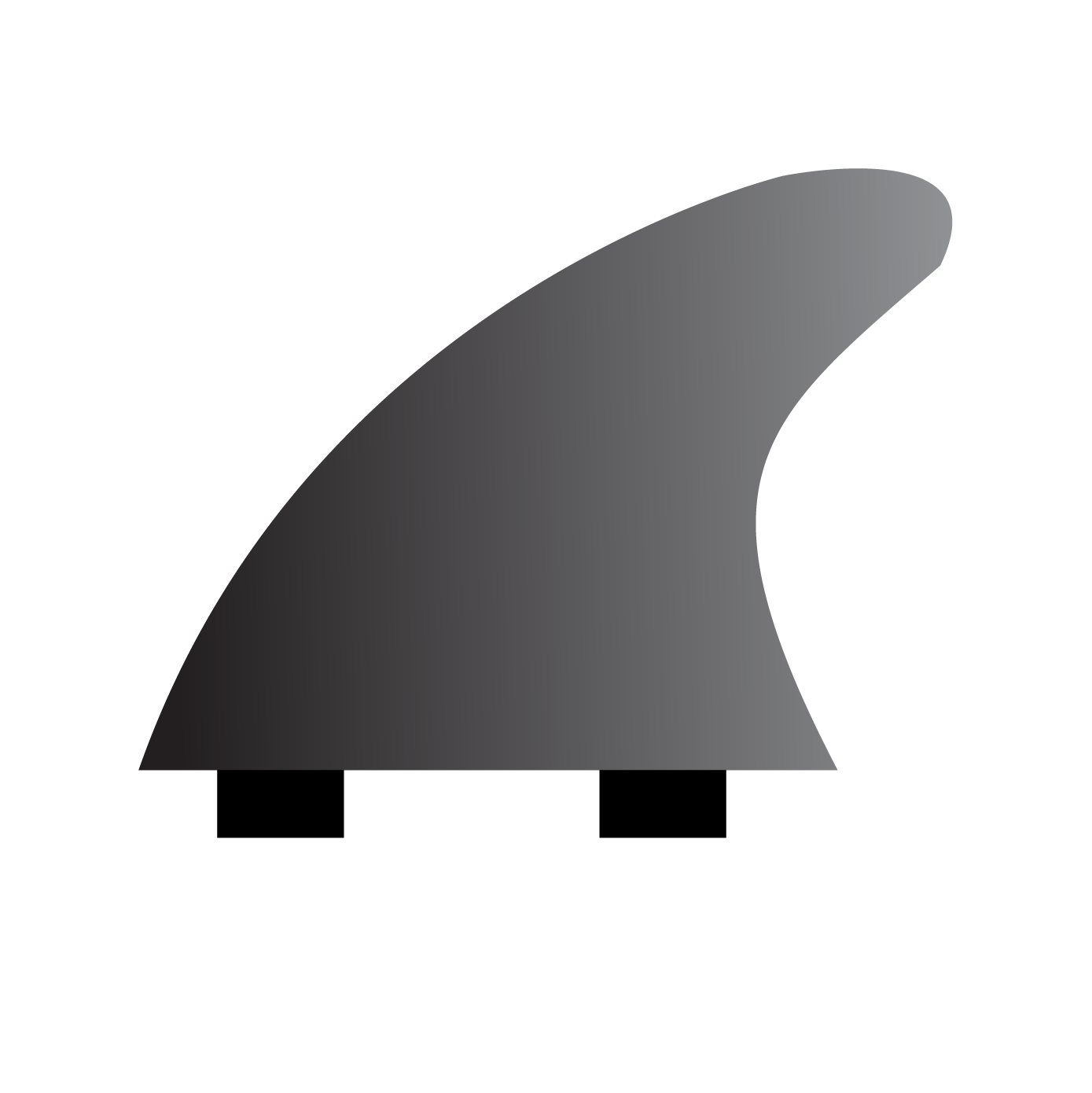
FCS II
FCS II is the new FCS system, and is also called ‘click tab’. This is one of the most handy systems out there when you are travelling because you can click your fins into your board without having to screw them in.
like the FCS I system there is two rectangular parts going into the board, but the front one is larger than the back one. View all our FCS II options
here.
Important to know is that, with a filler set by FCS, you can use FCS I fins in the FCS II click system. You can
not use FCS II system in the FCS I system.
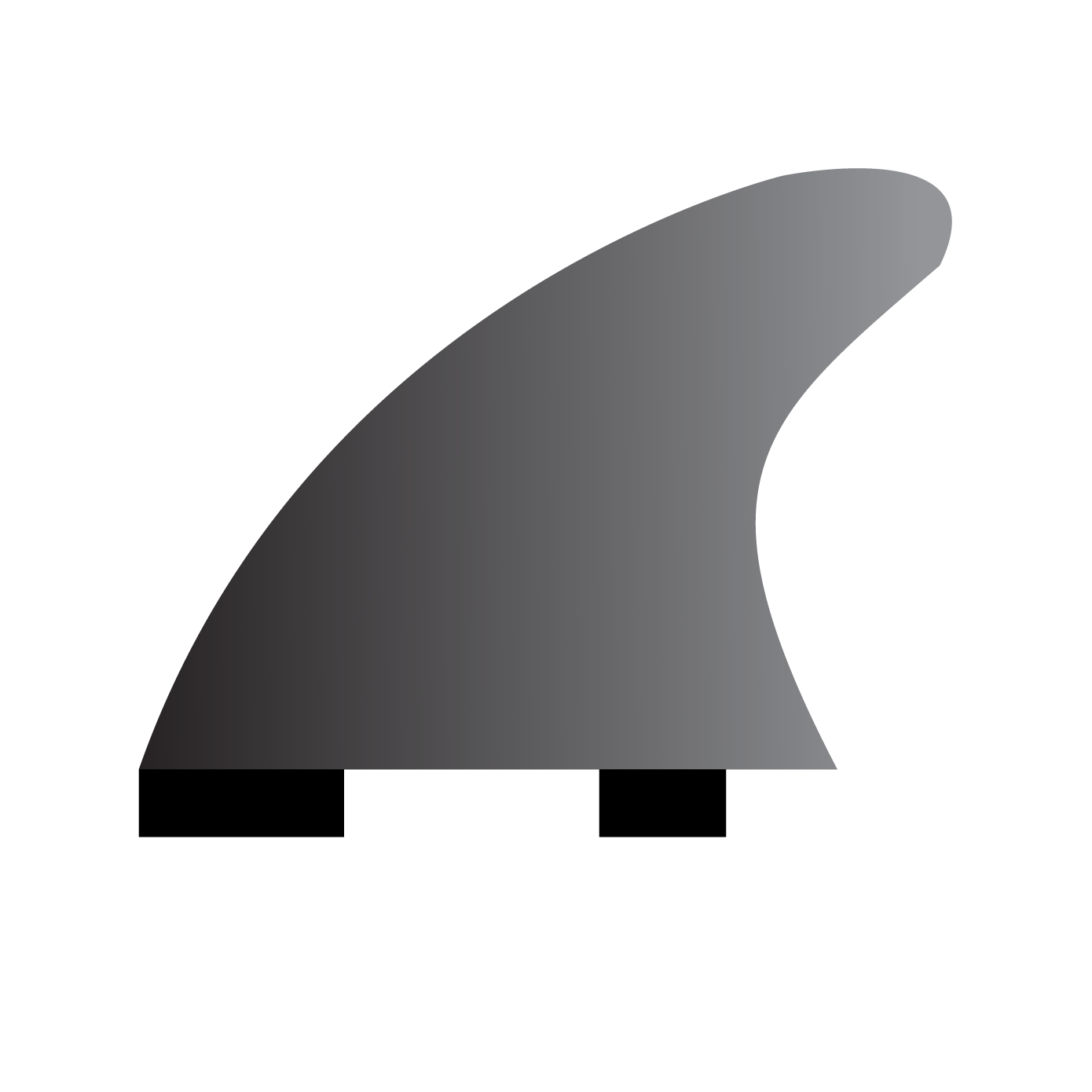
Futures
Futures is the big competitor of FCS and is also called ‘Single Tab’. You can recognise them by the single, long rectangular insert that goes over the length of the fin and into the board. View all our Futures options
here.
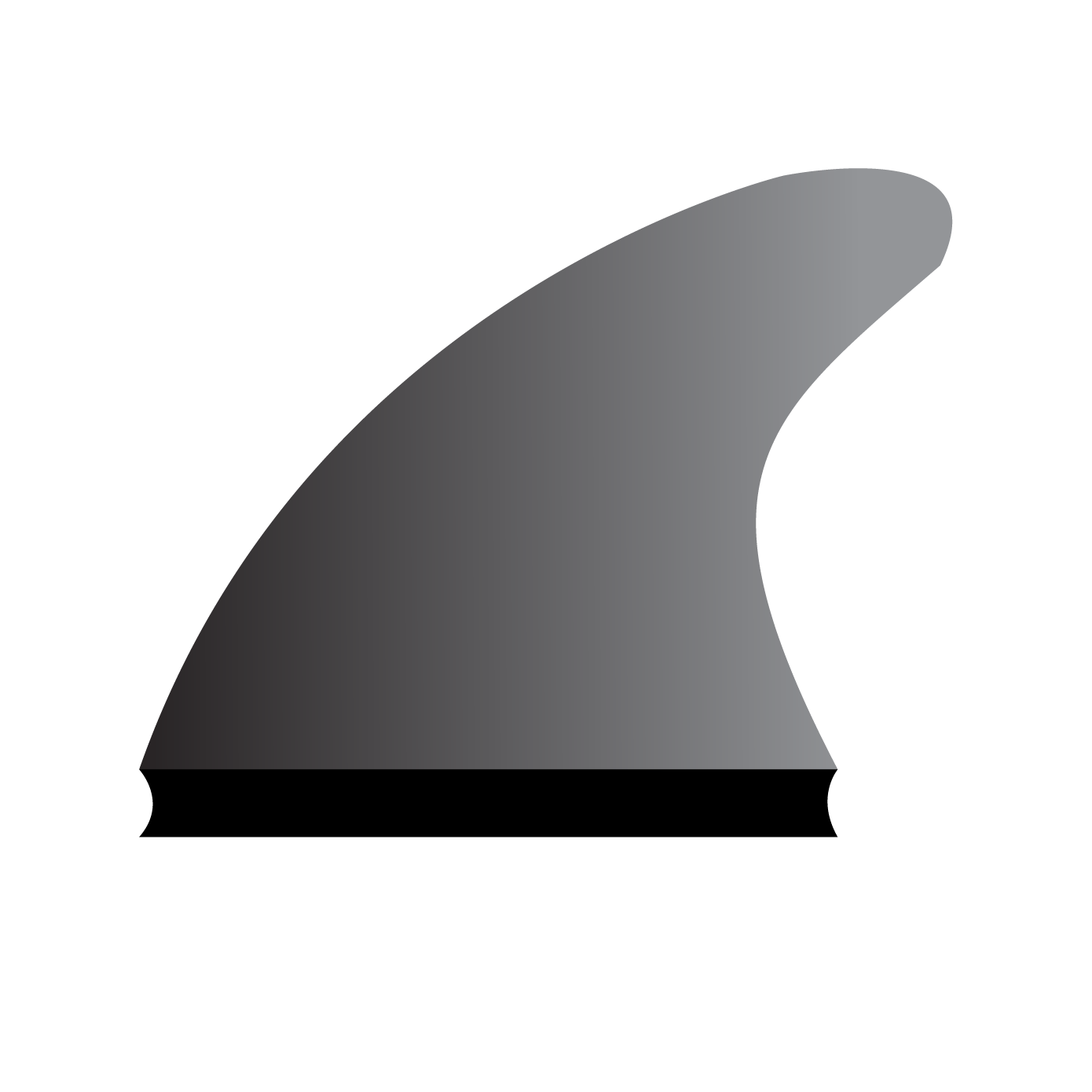
US Box
The majority of all of the single fins have a US Box in the tail. The finbox is much longer then the base of the fins that go in there, so you can decide for yourself where to place it on your tail. the fins that go in there have metal pins on the one side, and a hole on the other. You use a screw and screwplate to put it on your board. View all our US BOX options here.
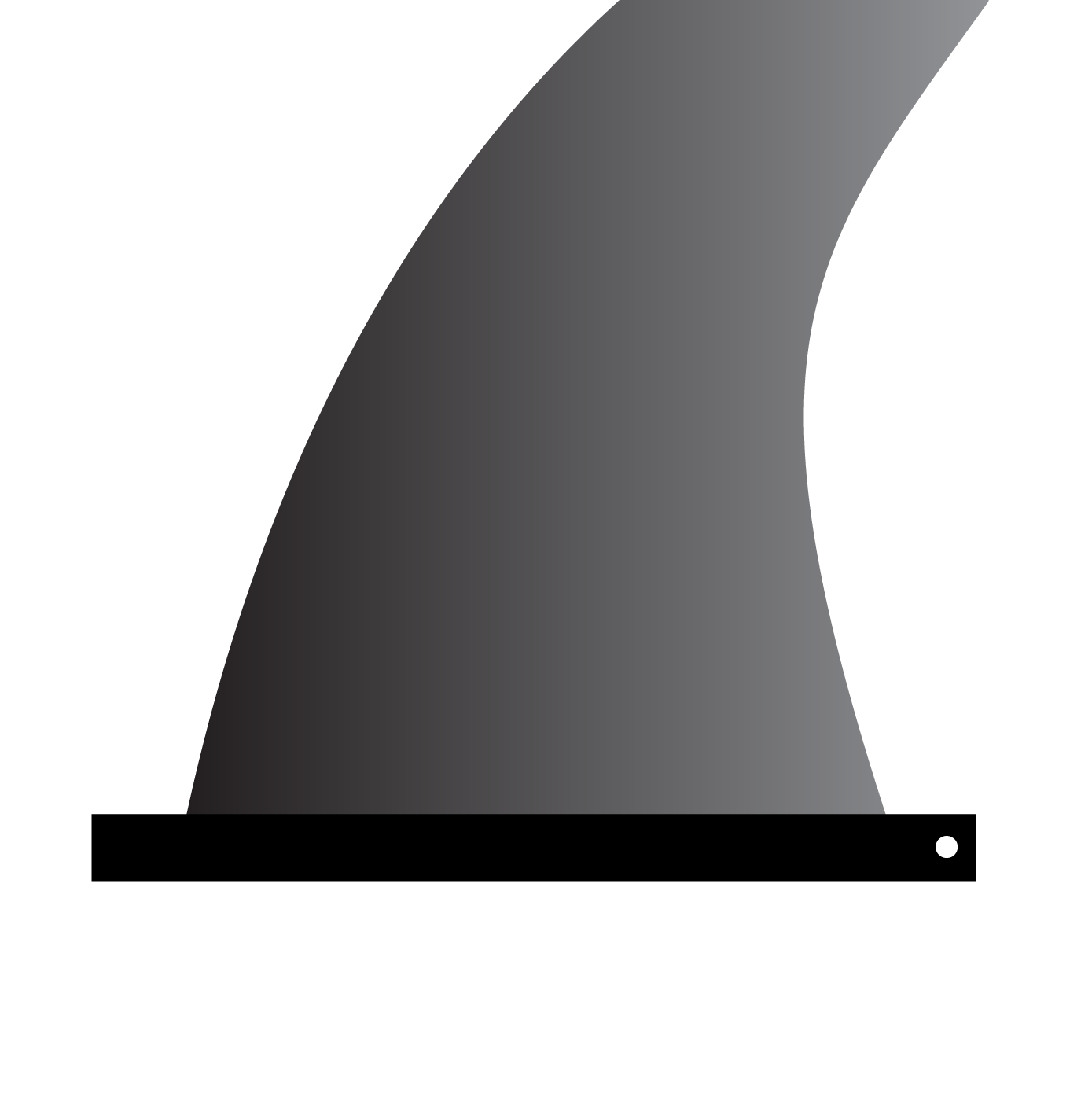
Question 2: What Fin setup is under je board?
IN the world of surfing there are thousands of different boards with specific fin setups to match them. however, the setups that reoccur most ofter are: Single Fin, 2+1, Twin Fin, Thruster (Tri Fin), Quad fin and 5-Fin.
So most boards have a predetermined setup in the board, but sometimes there are extra finboxes under the board, so you can choose for yourself what you wanna ride. That’s why it's good to know what each different setup does for your board.
Single Fin
A single fin is what you see a lot on longer and classic boards and the name says it all: it’s one fin in the middle of your tail. This setup gives you only function 1 of a fin: stability and pivot.
Often found on boards with a longer rail line, because those boards have a lot of grip from the long rail already. And the single pivot point creates a nice point around where you can turn the long board. Here are examples of single fin longboards to be found, but you can also go for a nice mid-length board with a single fin, like these.
Find our single fins here.

2+1
With a traditional 2+1 setup they mean that you would add small side fins to your single fin, for added hold and control(sometimes called sidebites). This changes your surf experience and you can choose to put a smaller middle fin in your board.
There is also fin setups where a 2+1 is meant as a twin fin, but with an added small middle fin (a trailer fin). This gives you a great blend that sits between a twin fin and a thruster setup. Check here for nice 2+1 options.


Twin Fin
Twin fins have two reasonable large side fins close to the rail of the surfboard and are both foiled. This is very nice to have when you ride a board with a shorter rail line and therefore, twin fin setups are mostly found on shorter boards or boards that are more round and (therefore less active rail in the water when surfing). Because there is no fin in the middle of the board, there is resistance in the water flow underneath the board and will therefore go nice and fast. You do miss the exact control of the middle fin though.
Inspiration for the twin fin came from the old hawaiian paipo fins (a classic bodyboard). Bob Simmons used them in the 50’s already, but hit the masses because of guys like Mark Richards who used them to get two world titles on them.

Check here for all of the twin fin options.
Thruster (Tri-Fin)
The Thruster is seen as the “best of both worlds”. You have the stability and pivot of a middle fin, but the hold and grip of a twin fin combined. The side fins of a twin fin are much larger than those of a thruster and the middle fin is much smaller than a single fin (they are all three similar in size).
The thruster is the brainchild of Simon Anderson. As a bigger man, he was looking for a solution that would make him surf better in the smaller waves on the World Tour at that time. He came across a local that used a small trailer fin on his twin, liked the idea and designed his own set in a totally different size. When it was perfectioned, he showed the world tour what was possible on them and everyone followed.
The thruster (or tri fin) is the setup that is used most out of all of these, and therefore has the most choices. Check here for all of our options.

Quad Fin
The quad fin setup works similar to a twin fin, but instead of one fin with each rail, there are two fins at each rail. They therefore also work very well on boards with a shorter rail line or that are more rounded.
Quads also work well when the conditions are heavy and you would love some extra speed and hold at the rail. That's why a lot of big wave guns have quad setups these days.
The difference between a quad and twin fin is that, because there is room between the two fins on each rail, you create a better pivot point. Click here for all of the quad options.

5 Fin
So if there are 5 finboxes under your surfboard, it doesn't necessarily mean that you need 5 fins for your board. It is mostly meant so you can choose for yourself if you would like to surf your board as a quad, or as a thruster. There are also board with 5 fins (like some bonzers for example) but they are more specialised. Check here all of the possibilities in store.
Question 3: What fin size do i need?
So by now you know what finsystem your board has and you have some idea of what you can and want to ride. We are headed to a sensitive topic now though:
What is your weight?
Be honest, this is not going on tinder anyways.
In the table underneath there is a sort of guideline for what size you should grab of a type of fin. We encourage people to try different sizes if that is possible (try your buddies fins for example), so you can find out what works well for you.
Press the sizes in the table to view the options we have.
|
Size
|
Weight lbs
|
Weight Kgs
|
|
Grom XS
|
75 - 115lbs
|
35 - 52kg
|
|
Small
|
105lb - 155lb
|
47 - 70kg
|
|
Medium
|
145 - 180lbs (at Futures 145-195lbs)
|
65 - 80kg (at Futures 65-88kg)
|
|
Large
|
165lbs+ (at Futures 180lbs+)
|
75kg+ (at Futures 80kg+)
|
* This is not how Single fin sizing goes, If you are looking for a single fin, then go to the ‘Single Fins’ part in question 4
Question 4: what kind of fin do I need?
So now we are going to enter the more technical part and dive into the wild west of fin geometry. You can go full nerd on this and select the right sized and textured fin to your liking up to the last millimeter, but luckily for the ones that don’t want to do that, you dont have to. The two main brands have put their fins in ‘families’ (FCS) or have given them ‘ride numbers’ (Futures).
But there are way more brands than just FCS and Futures, that do use their systems. They are not in these fin families or have ride numbers, so then it's good to know what goes into a surf fin.
Do you dont feel like reading about fin geometry and are you just looking for a fin by either FCS or Futures that will suit you? Then you could skip to FCS of Futures. If you want to learn more or buy fins from the third party brands also: enjoy!
Fin measurements and geometry
Next to the different setups and sizes, fins can be designed in a lot of ways. To help you in your choice, we would love to teach you about all of the different aspects of a fin that you can take into account. We are going to talk about the sweep (rake), toe, base, length, foil, height and cant of a fin.
Sweep (rake)
The sweep, or rake, is how far the front edge of a fin arcs backwards. Rake or sweep angle is a measurement that determines how far back the fin curves in relation to its base. Fins with a small rake (large offset) help propel the board, are very stable and predictable but are not ideal for making sharp fast turns. On the other hand, fins with a large rake angle and a small offset will allow your board to have a tighter turning radius, but are more “squirrelly” and playful.

Toe/Splay
The toe or splay of a surf fin is defined as the angle of the side fins in relation to the board’s central stringer. Side fins are typically referred to as “toed-in,” with the front of the fin angled towards the middle of the board. This causes water to pressure the outside of the fins, for increased responsiveness.
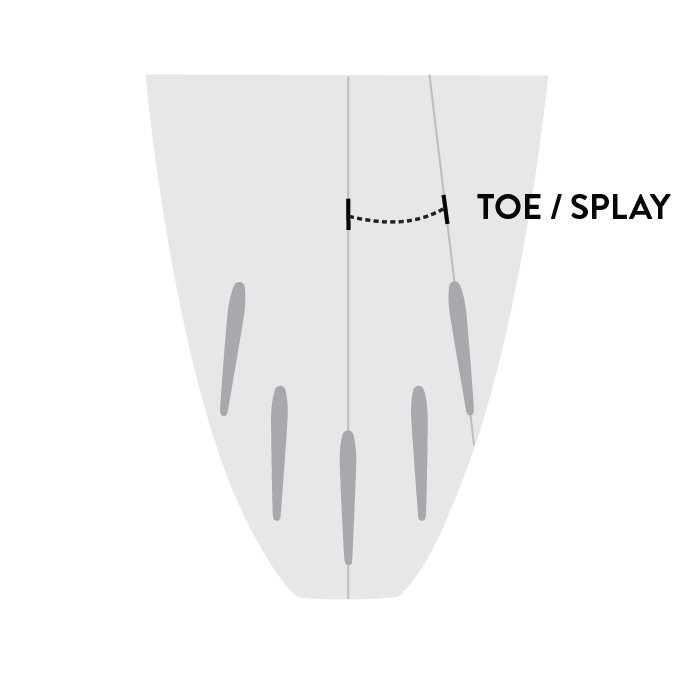
Base (Length)
The base length of the fin is the widest point of the fin, and sits flush with the board once installed. This length can affect how the board will respond to turns. Longer fin bases create trajectories for water to go past – so your surfboard will move faster. If you want to make sharp turns, however, go for a shorter fin base length.
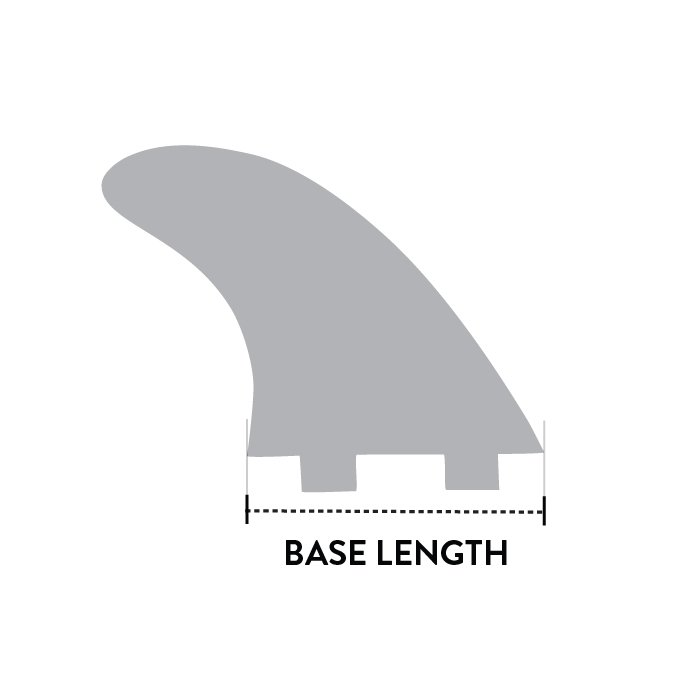
Foil
The fin foil is an aerodynamic shape from front to back of the fin. Much like the wings on an plane, this foil generates lift under the board. A fin is usually going to get thicker through the center of the fin and taper smaller out towards the edges.
There are 4 different kinds of foil that are used most of the time: 50/50, flat foil, inside foil en 80/20.
Almost every mid fin has a 50/50 foil but with the side fins its a different story, so here a brief explanation:
50/50
A symmetrical foil used for center fins and some quad rears. Water flows evenly over both side of the fin creating stability and control.
Flat Foil
The flat inside edge creates an even balance of drive and hold. Great for fast turns, speed and top to bottom surfing.
Inside Foil
The scooped out inside face (concave) and rounded leading edge lets water flow efficiently over the faces which adds lift and hold whilst maintaining speed.
80/20
Used mainly for quad rears. The asymmetrical foil is like a 5050 but off-centre, and has increased sensitivity and hold.

Flex
The flexibility of a fin, or lack thereof, can significantly affect the way a surfboard rides. In general, a flexier fin will provide a skatier feel on more playful waves, but a stiff fin is ideal in faster more hollow waves.
It is important to note that high end fins can be both soft and stiff – they have flex patterns. Many fins now have a stiffer base for tracking and stability, with a softer tip that make it easier to break your board loose while turning.

Height/Depth
The height (often referred to as the depth) is measured from the base of the fin to the tallest point of the fin. This measurement can change your board’s stability and ‘grip’ through turns. For surfers who desire a board that is easy to control, a taller fin will be more forgiving and handle turns in a relaxing manner. Shorter fins do not grip the water as well, but rather allow the board to be more “buttery” when turning, ideal for spin-like maneuverers on the water, for example.
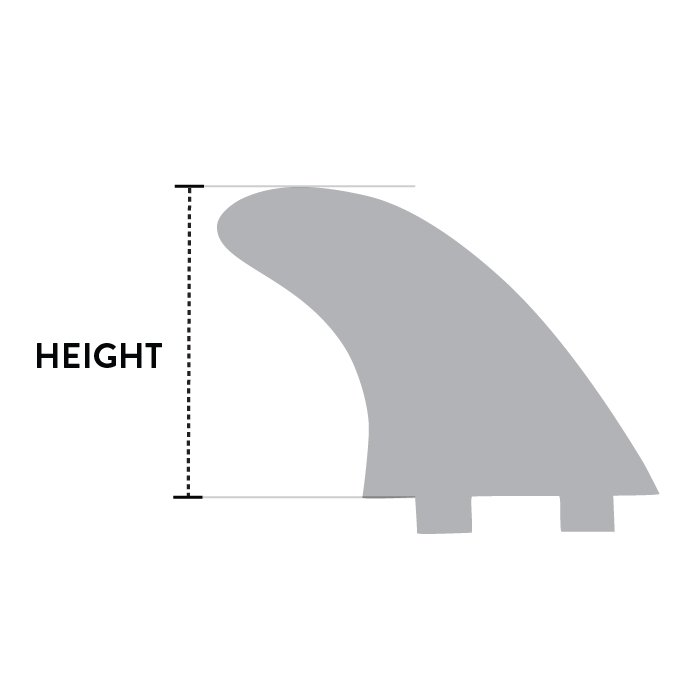
Cant
Cant is the tilt of the fin in degrees, in relation to the base of your surfboard. For example, a fin that is straight up down and in the fin box has no cant (90°) and will likely make your ride faster, while anything more than 90° will increase responsiveness. In order to enhance rider-to-board connectivity and responsiveness, especially through turns, you will benefit from canted fins. The less cant a fin has the more drive and acceleration your board will have but will also be less playful. In turn, the more cant a fin has the looser and more maneuverable your surfboard will feel.

The FCS Fin Family
FCS had placed their fins in 4 different families:
Reactor, Performer, Accelerator and Carver.
Each of these families had it’s own characteristics, made out of the elements described earlier, that make them ideal for a certain waves or style of surfing.
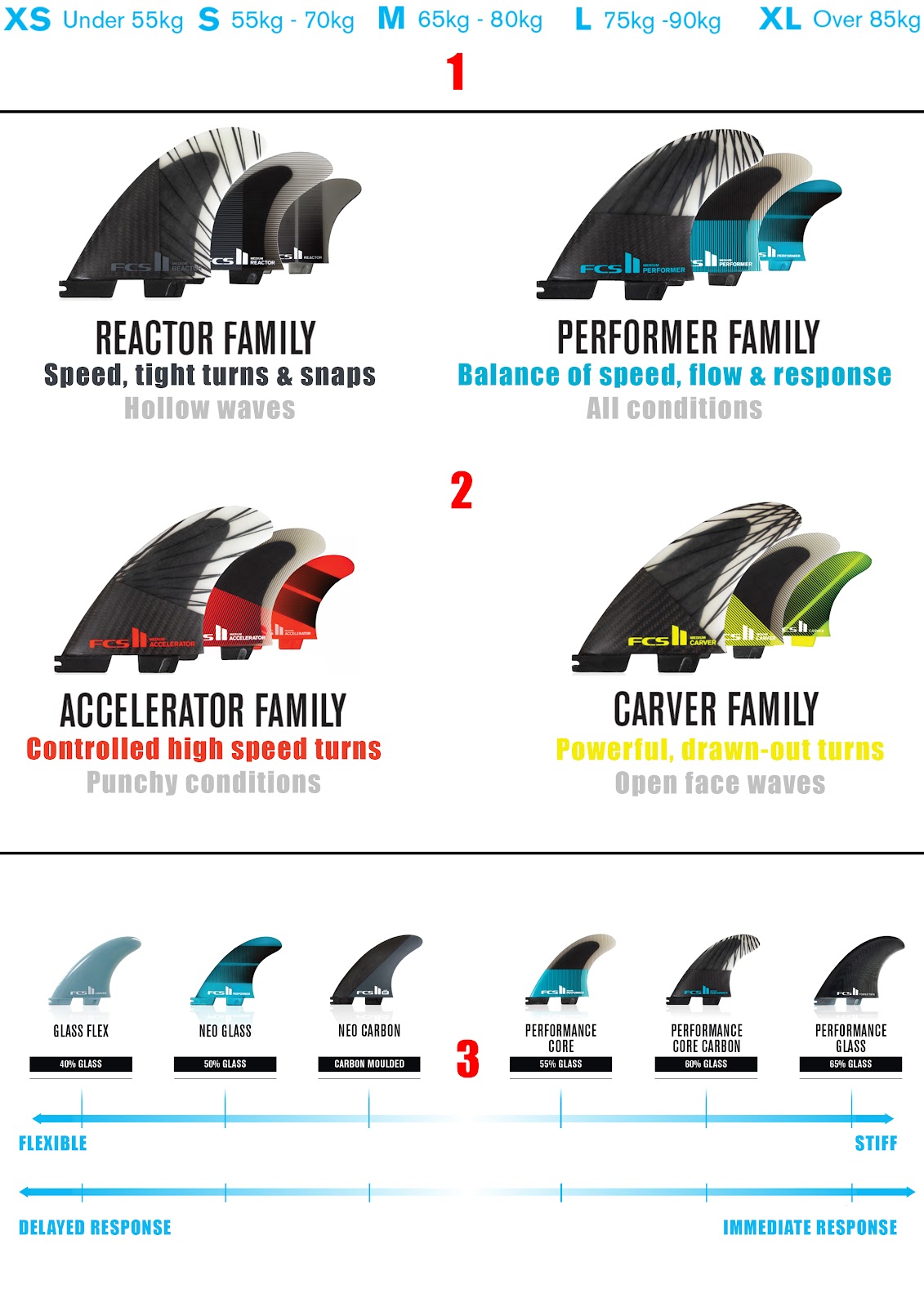
Within these families, there are different fins and pro models that have each their own characteristics (flex pattern, cant, etc.). So within one fin family, two different models could have the same shape, but are made out of different materials, which make them react differently.
These different materials are described below:

To give you an example:
In the fin family Performer, you have the standard performer fin in Neo Glass. This fin family has the characteristics of a Balanced template for speed, flow and response. Now the neo glass material gives you a bit of a delayed response.
would you choose to get the same standard preformer fin, but then in Preformance Core Carbon (PCC), it would still have that same balanced template of speed, flow and response, but it would have less flex and a more immediate response than the Neo Glass version.
An overview of what fins fall under which family, can be found here.
“INsert pdf’
Futures
Futures has its own system and uses a Ride Number to show you how the fin will react and where it’s meant for.
On the scale below you can find what the ride number tells you (on a scale from 10 to 1) if the fins are meant for Speed Generating (10) or meant for Speed Control (1).

Fins on the Speed Generating side will be more flexible and have a more delayed response. These are more ideal for when the waves have less power. Do the Waves provide the power already, and you need to control more what to do with the speed and power, go for a fin more on the speed control side.
Their rule of thumb is:
“If you are pumping - Speed Generating, If the waves are pumping - Speed Control.”
The ride number is built up out of different aspects of flex, rake and foil, of which flex and rake are the the most prominent contributors.
Find all of the Futures fins and their ride numbers (in the description) here.
Extra Tips
- You never know for certain and don’t be lazy. Try diffferent fins and different fin setups in your boards. It can give your board a whole new life and feel.
- Loose boards will have better drive if they have a more stiff and bigger fin with more sweep. Stiff boards can made a little more playful if you use a more flexible fin with less sweep.
- Surfboards with wide tails work well with a larger fin.
